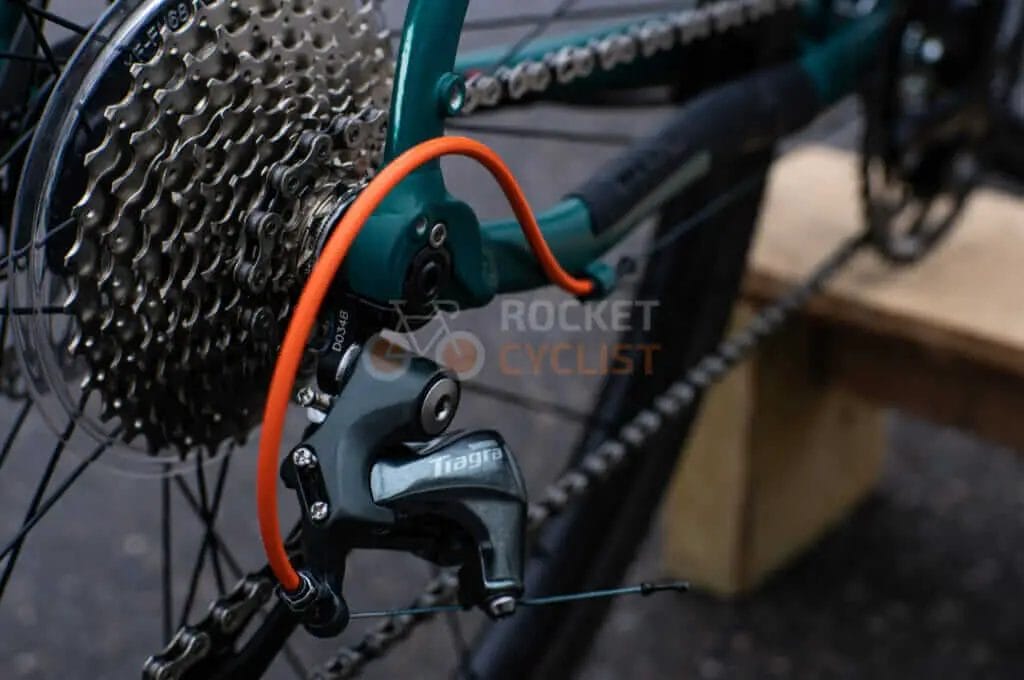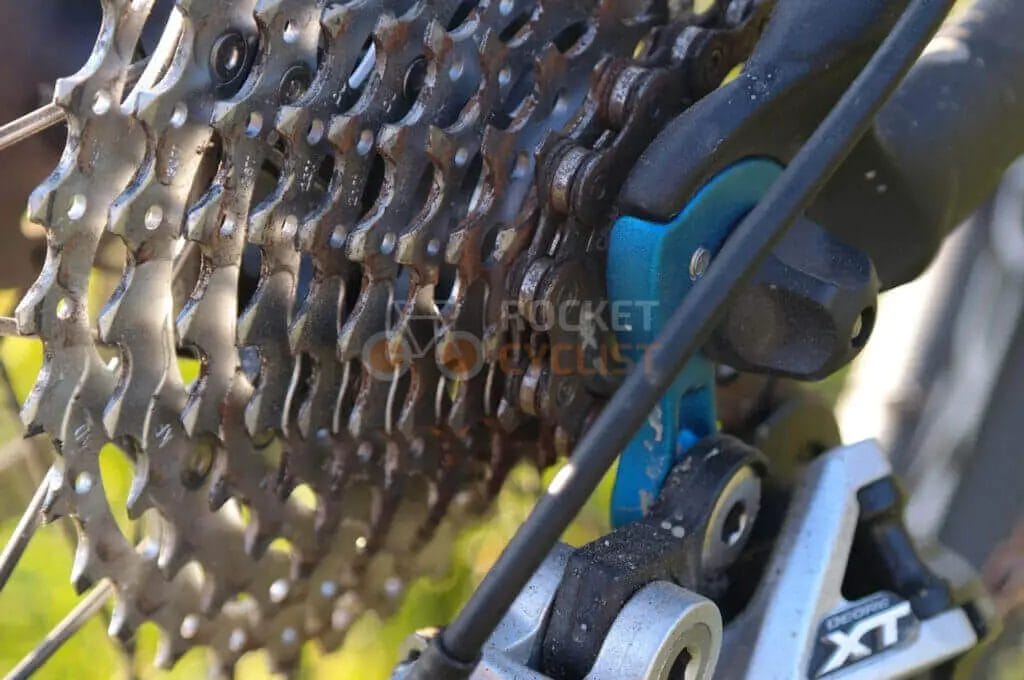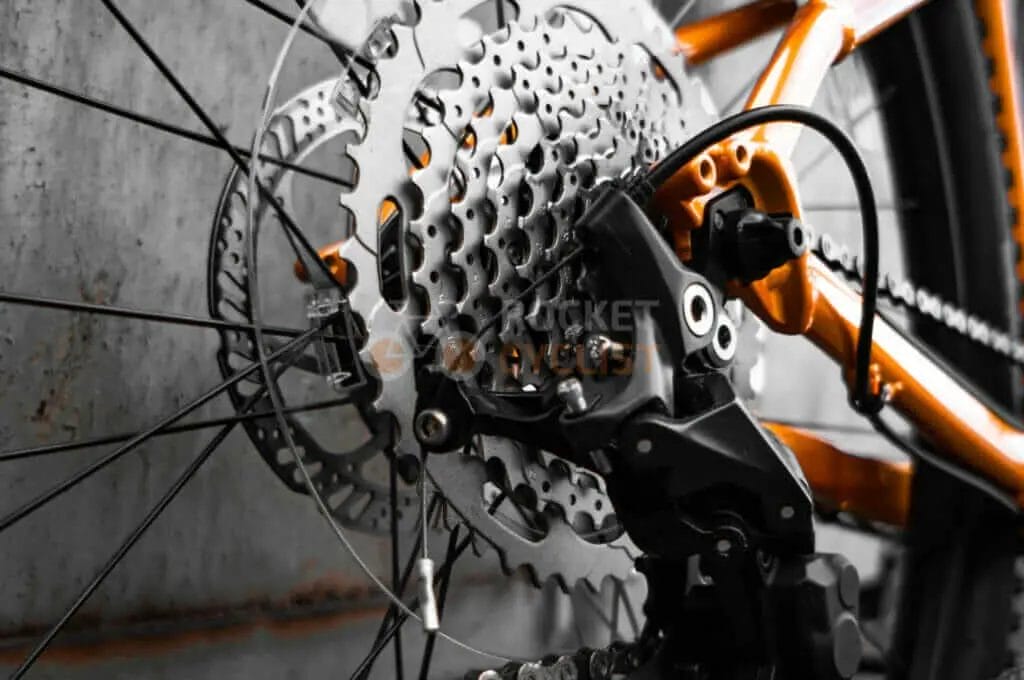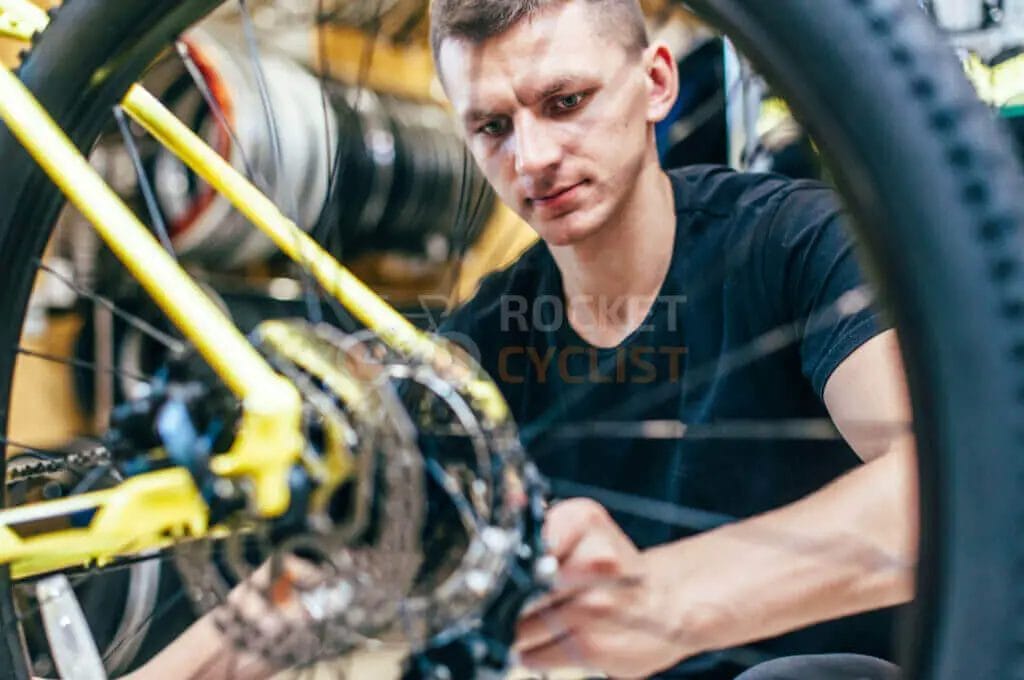Last Updated on March 22, 2024 by Vinson Lozano
What is a Bike Dropout?
A bike dropout is the part of a bicycle frame or fork where the bicycle’s wheel is attached.
Definition and function of a bike dropout
Bike dropouts are a key component that forms part of the bike frame. It basically serves as slots where the wheels are placed. They typically house the axle of the wheel, providing a receiver for the axle to secure wheels in place and align them correctly.

Types of bike dropouts:
- Horizontal Dropouts: These are classic dropouts design that allows the wheel to be moved back and forth to adjust the bike’s chain tension.
- Vertical Dropouts: This design allows for easier wheel removal and installation, as they simply allow the wheel to drop down and out.
- Through Axle: A modern design that allows the axle to pass directly through the dropout and frame, providing increased stiffness and durability.
Importance of bike dropouts in bicycle design
In the world of bicycle design, bike dropouts play an important role in how the bicycle rides and handles. They affect the bike’s wheelbase, the distance between the wheels, as well as its chain tension. Having a well-designed dropout can help improve the overall performance and reliability of the bike.
In conclusion, bike dropouts might not be the most glamorous part of your bike, but they play a crucial part in how your bike functions. Without them, we wouldn’t be able to securely attach the wheels to our bikes.
Types of Bike Dropouts
A bike dropout is the part of a bicycle frame where the front and rear wheels attach. Depending on how a cyclist intends to use their bike, there are four main types of dropouts to consider:
Horizontal dropouts
Horizontal dropouts were a common sight on older bikes and are still used by some manufacturers today. The advantages of this style are that it offers the cyclist flexibility in terms of gear ratio adjustments and chain tensioning. They’re perfect for single-speed or fixed gear conversions.
Vertical dropouts
The vertical dropouts are the most common style in modern road, mountain, and hybrid bikes. They allow for quick release of the wheel and ensure that the wheel is correctly aligned each time it’s installed. One possible downside is that they don’t allow for chain tension adjustment.
Sliding dropouts
Sliding dropouts are a type of adjustable dropout found on some bikes, offering the ability to adjust chain tension by moving the position of the rear axle back or forward. This makes them suitable for fixed gear, single speed and internally geared hub systems.
Adjustable dropouts
An adjustment freedom is the main feature for the adjustable dropouts as they allow changing geometry and fit of the bike, so you can fine-tune your ride based on personal preferences and riding conditions.
To sum up, the type of bike dropouts you choose depends on your cycling needs. Whether it is for road racing, mountain biking, freestyle or urban commuting, there’s a suitable dropout style out there for everyone.
Pros and Cons of Different Bike Dropout Types

Bike dropouts play a crucial role in handling and performance depending on the type of ride, whether it be road biking, mountain biking, or any cycling style. Their chief purpose is to hold the wheel in place and maintain alignment.
There are different types of dropouts to cater to the cyclists’ diverse needs like horizontal, vertical, sliding, and adjustable. The following comparisons will guide you in picking the apt one based on your needs.
Advantages and disadvantages of horizontal dropouts
Horizontal Dropouts, from the golden age of cycling, are loved by fixie and single-speed riders. The most evident benefit is the freedom to adjust the chain’s tension. However, there can be difficulty aligning the wheel correctly, and inadequate skewer pressure can cause the wheel to move under heavy load.
• Pros: Adjustability for chain tension, ideal for single speed or fixed gear bikes.
• Cons: Difficult to align the wheel, possible wheel slippage.
Advantages and disadvantages of vertical dropouts
Modern bicycles predominantly feature Vertical Dropouts. They allow easy wheel removal and replacement without worries about wheel alignment. It’s a great convenience for riders with derailleurs, but these dropouts do not permit any adjustability in wheelbase or chain tension.
• Pros: Easy wheel removal and installation, ensures accurate wheel alignment.
• Cons: Lack of adjustability in wheelbase or chain tension.
Advantages and disadvantages of sliding dropouts
Sliding Dropouts are a perfect blend of the vertical and horizontal types. They offer easy wheel installation, alignment assurance, and chain tension adjustability. But, they are heavier and more complex in design, which may require professional assistance for adjustments or replacements.
• Pros: Chain tension adjustability, accurate wheel alignment.
• Cons: Heavier, complex design.
Advantages and disadvantages of adjustable dropouts
Adjustable Dropouts are a highly flexible choice, offering both axle positioning and geometric adjustments. This ability to tune the bike’s characteristics is invaluable for experimentative cyclists, but additional parts can add to its weight and complexity.
• Pros: Highly adjustable, can change the bike’s geometry.
• Cons: Can be heavy and complex.
Choosing the right type of bike dropout ultimately comes down to your specific biking requirements and style preference. Understanding these advantages and disadvantages can help you make an informed decision.
Factors to Consider When Choosing a Bike Dropout

When procuring a bike dropout, several components demand careful consideration to ensure optimal performance. Here are a few important features to contemplate before making your selection:
Frame compatibility
The bike dropout you choose must be compatible with your bike frame. This is critical because the dropout is designed to fit a specific frame – the connection point for vital components such as your rear wheel, brake, and derailleur. Cross-checking the manufactures’ recommendations can aid in ensuring proper fit.
Wheel size and axle spacing
Wheel size and axle spacing are additional factors that affect dropout choice. Larger wheels may require wider dropouts to accommodate the increased size, while different axle types (quick release, thru-axle, etc.) demand corresponding dropout designs. Consider the size and type of your wheel for an appropriate fit.
Single speed vs. multi-speed compatibility
The kind of drivetrain your bike has can also influence your dropout choice. For bikes with a single-speed setting, a dropout that allows tensioning the chain, like a horizontal or sliding dropout, is beneficial. In contrast, bikes with multi-speed or gear settings typically require vertical dropouts, which contend well with the tension provided by the derailleur.
To sum up, take into account the following aspects while selecting the bike dropout:
- Compatibility with your bike frame
- Wheel size and axle type
- Compatibility with your bike’s speed settings
By considering these factors, you ensure that the bike dropout you choose contributes positively to your bike’s performance and longevity.
Popular Bike Dropout Brands and Models

If you are an enthusiast cyclist or a professional mountain biker, the term ‘dropout’ significantly impacts your cycling experience. With the increasing number of brands and models in bike manufacturing, finding a reliable bike dropout could be overwhelming. We present a quick list of notable dropout brands and bicycle frames renowned for their trustworthy dropout systems:
Notable bike dropout brands in the market
• Paragon Machine Works: Known for their premium quality, Paragon Machine Works offer a range of versatile and durable bike dropouts. Their precision parts for cycling enthusiasts and bike builders alike have consistently exhibited top-tier performance.
• Shimano: A brand that needs no introduction, Shimano also produces bike dropout systems. Their commitment to quality is evident in their meticulously crafted dropouts that ensure the bike gears shift smoothly and provide a seamless riding experience.
• Surly: Surly is another reliable name when it comes to bike dropout systems. Its robust designs ensure the wheel is held precisely where it should be, guaranteeing a safe and efficient ride.
Top bike frames with reliable dropouts
• Cervelo R5: The Cervelo R5 frame is admired for its lightweight design and superior dropout system that offers precise gear alignments and smooth transitions.
• Giant TCR: Known for its excellent stiffness-to-weight ratio, the Giant TCR frame has a reliable dropout system that firmly holds the wheel in place for safe and efficient biking.
• Trek Madone: The Trek Madone frames are well-regarded due to their aero-design and high-quality dropout systems that ensure optimal wheel alignment and smooth gear shifting.
Remember, different dropout designs can significantly affect the handling, gear shifting, and overall performance of the bicycle. So, ensure you are selecting a bike or a dropout system that is most suitable for your biking needs and preferences.
Bike Dropout Maintenance and Repair

Proper bike dropout maintenance and repair are crucial for ensuring your bike’s longevity and performance. This section will cover two main aspects: cleaning and lubricating the dropouts and replacing a damaged dropout.
Cleaning and Lubricating Bike Dropouts
Regularly cleaning and lubricating bike dropouts is essential to maintain the bike’s overall performance. Here’s a simple step-by-step process:
- Start by removing the rear wheel.
- Use a clean, soft cloth to wipe away any dirt or grime from the dropouts.
- Apply a quality bike lubricant on the dropout and the quick-release mechanism.
- Attach the rear wheel back and ensure it’s secure.
Remember, proper lubrication prevents rust and ensures smooth operation of the quick-release mechanism.
Replacing a Damaged Dropout
Replacing a damaged dropout can be more complex and sometimes requires professional help. However, if you feel comfortable doing it yourself, follow these steps:
- Begin by removing the rear wheel and the derailleur.
- Take out the screws holding the dropout in place.
- Install a new dropout and secure it with screws.
- Attach the rear derailleur and wheel back onto the bike.
In conclusion, maintaining your bike dropout will help ensure a smoother ride and prolong the life of your bike. However, when replacement becomes necessary, don’t hesitate to seek professional help if needed. Regular inspection will prevent small dropout issues from developing into significant problems.
Upgrades and Accessories for Bike Dropouts
Stepping up your cycling game requires not just a good bike, but also the right accessories and upgrades. Among the most overlooked parts of a bicycle, yet carrying a significant impact on bike safety and performance, are the bike dropouts. Here, we explore some upgrades and accessories that can enhance your bike dropouts.
Dropout Alternatives like Thru-Axles and Bolt-On Systems
Thru-axles and bolt-on systems are major alternatives to the traditional dropouts. Thru-axles enhance stability and control by securely connecting the wheel to the bicycle frame. These are especially common in mountain bikes.
Bolt-on systems, meanwhile, provide an added level of security. These systems do not offer quick-release features, making them a solid choice for cyclists concerned about wheel-theft.
Upgrading from a quick-release skewer to a thru-axle or bolt-on system can enhance both performance and security.
Dropout Adapters and Conversion Kits for Different Axle Standards
Dropout adapters and conversion kits can assist in aligning your bicycle to different axle standards. These are especially useful when upgrading a bicycle’s wheelset or moving components between bikes with varying axle dimensions.
These accessories can make a significant difference in how your bike performs and fits you, which can be a game-changer for cycling enthusiasts. Choosing the right one requires an understanding of your riding style and the conditions in which you ride.
Investing in dropout upgrades and accessories is a move towards not just better bike performance but also a safer and more enjoyable cycling experience.
Conclusion
As we come towards the end of this engaging exploration of dropouts in 2023, let’s shift our gears and discuss the importance of choosing the right bike dropout for your cycling needs.
Choosing the right bike dropout for your needs
Selecting the right bike dropout is a crucial factor to consider, especially if you’re into cycling, whether you’re a professional cyclist or a biking enthusiast. The type of bike dropout not only impacts the bike’s performance but also influences the comfort, durability, and versatility of your cycling experience. Some dropouts provide better wheel alignment, while others provide scope for derailleur installation or easy wheel removal.
Let’s consider a few key aspects to be mindful of:
- Fixed or Replaceable Dropouts: Fixed dropouts are integral to the bike frame, offering durability and stiffness, whereas replaceable dropouts let you switch between single-speed and geared setups.
- Vertical or Horizontal Dropouts: The vertical dropouts support quick and smooth wheel removal and fitting, perfect for road bikes. However, horizontal dropouts provide improved wheel adjustment and suit single-speed or fixed gear bikes.
- Through-Axle or Quick-Release: The through-axle systems offer increased rigidity and strength, fitting for mountain bikes or disc brakes. On the other hand, quick-release systems are lighter and easier to use, apt for road or city bikes.
Choosing the right dropout requires considering your bike’s usage, desired performance, and specific wheel-setup preferences. In conclusion, the world of bike dropouts is vast, and investing some time in understanding their intricacies can significantly enhance your cycling experience.
Pedal on!


